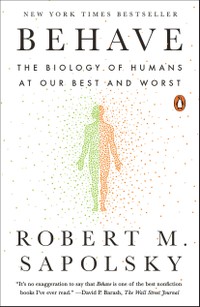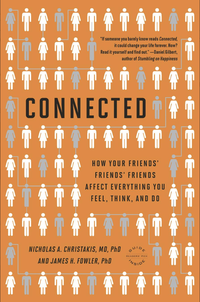Seven Books That Explain What Makes Other People Tick
8 min read
Other people can be baffling. Even in our closest relationships, loved ones frequently behave in ways that can seem inexplicable. Why can’t your friend recognize her self-destructive foibles? Why do you find your co-worker so grating? Partners insist on misinterpreting each other; voters are convinced that their political opponents are irredeemably wrong—and in these disputes, the other side’s point of view feels not just incorrect but also completely alien. In short, why are other people like this?
We can’t read people’s minds, but we can do the next best thing: read books. A perceptive memoir or work of fiction, for example, can help you see the actions of others anew. A deep dive into the science of the brain can offer fresh ways to understand our fellow humans—as individuals who are influenced by their upbringing, their social networks, and the places they’ve lived. The selections below lay bare the fundamental mental equipment we all share; they suggest frameworks for appreciating different personalities. The most entrancing literature can even feel like quality time with someone—the kind that allows their idiosyncrasies to become deeply familiar. These books do their part in clearing up the mysteries of human behavior. Reading them may help you make sense of another’s actions—and perhaps even your own.

Behave, by Robert M. Sapolsky
What happens in our brain before we perform certain acts—moves as minor yet consequential as pulling a trigger, or as quick and instinctual as touching someone else’s arm? In this revelatory, 800-page book, Sapolsky, a neuroscientist and primatologist, dedicates himself to teasing out why we behave the way we do. And the realms he traverses are many: Readers will get a detailed course on how neurons and neurotransmitters work, the effects of stress on cognition, and the ways that fetal exposure to certain hormones can shape the brain. But Sapolsky also zooms out to cover the roles of culture and evolution. His aim is to explore people at “our best and worst,” and certain key questions recur throughout the book. How does our brain make moral decisions? How should we interpret our tendencies toward violence, hierarchy, and tribalism? And—a doozy—do we have free will? (In his most recent—and controversial—book, Determined, he argues that we do not.) Sapolsky leads us with a comforting chattiness through the mazes of overlapping scientific debates; his prose is rigorous but surprisingly fun. Reading Behave can feel like paging through an operating manual for our bewildering human machinery: Its insights are useful, eye-opening, and important.

Middlemarch, by George Eliot
Those craving an immersive exploration of the human psyche should look no further than this towering classic novel. Although most readers wouldn’t describe Eliot’s study of a provincial 19th-century English town as a work of psychology, it dissects the interlocking lives of the residents with an astute eye toward what drives them. The characters in its sprawling cast—among them the ardent, generous Dorothea Brooke and the ambitious doctor Tertius Lydgate—make ill-advised marriages, run up against obstacles to their ambitions, allow their reputations to be besmirched, and fall into debts that they struggle to repay. Much of the novel’s drama comes from the mutual incomprehension that arises between individuals (particularly married couples), and Eliot tracks with riveting detail the feelings and thoughts on both sides of a disagreement. Even the briefest flash of emotion on a face or the intonation of a phrase can set off a chain of misunderstandings, and the reader is privy to each character’s shortcomings as they form unrealistic expectations and read their own preoccupations into their interlocutors’ words. Total understanding of others is impossible, the novel suggests. And yet, thanks to Eliot’s keen sensitivity, reading Middlemarch might just enlarge your capacity to imagine other people’s state of mind.


Darkness Visible, by William Styron
At 60, Styron was stricken with an episode of severe depression, one that incapacitated him and brought him to the brink of suicide. In this slim book, he attempts to put words to his experience of a disease that is “so mysteriously painful and elusive,” he writes, “as to verge close to being beyond description.” We gain an intimate sense of the illness from its beginnings, when Styron found that alcohol—a substance he had been “abusing for forty years”—suddenly triggered nausea and revulsion. His abstention kicked off a malaise that culminated in a determination to kill himself in his Connecticut farmhouse, ending only with his subsequent hospitalization and recovery. Sections about depression’s causes and treatment are woven in elegantly among meditations on suicide, an act that, Styron argues, should have “no more reproof attached than to the victims of terminal cancer.” The depths of depression are nearly incomprehensible to those who haven’t experienced it, yet Styron’s rich, precise language allows his readers to grasp his suffering—and gives us a glimpse into the workings of his particular mind.


Connected, by Nicholas A. Christakis and James H. Fowler
To truly understand people, don’t focus on individuals or groups, the social scientists Christakis and Fowler write. What matter are the connections between people: the branching paths that extend from you and your family, friends, colleagues, and neighbors to, say, Kevin Bacon. The book sketches out the surprising ways that these social networks sway our behavior, moods, and health, and its conclusions can be mind-bending. If your best friend’s sister gains weight, for example, you’re more likely to gain weight too, they write. Who we know significantly affects whether we smoke, die by suicide, or vote, thanks to our human tendency to copy one another. Happiness and sadness also spread among groups, so that the mood of a person you don’t know can sway your own emotions—even though we often imagine that our internal states are under our personal control. “No man or woman is an island,” the authors write. Their book makes a convincing case that our tangled relationships determine nearly everything about how our life plays out—and reminds us that we can’t be meaningfully understood in isolation.


Milkman, by Anna Burns
Milkman takes place in what appears to be 1970s Northern Ireland during the Troubles—hijackings, car bombs, and “renouncers-of-the-state” form its tumultuous backdrop—and it paints a chillingly sharp portrait of a community consumed by paranoia and violence. When its unnamed narrator appears in public with a menacing figure known only as Milkman, rumors begin to spread that she’s his mistress. Never mind the fact that the attentions of Milkman, a high-ranking paramilitary member who seems to follow her everywhere and utters oblique threats, are entirely unwanted. Where she lives, the narrator tells us, “you created a political statement everywhere you went, and with everything you did, even if you didn’t want to.” To protect herself from the gossip and from Milkman himself, the narrator is forced to become a “carefully constructed nothingness.” She adopts a blank expression and confides in no one—an emotional state that mirrors the hollowed-out hopelessness and self-deception of her neighbors. Burns’s dense, discursive style captures the narrator’s psyche intimately: We feel with her as she wrestles with the fear, suspicion, and longing she hides from the world, and as she observes the corrosion of an entire city under duress.


The Personality Brokers, by Merve Emre
We often speak of “personality types” and take for granted that individuals’ inherent qualities can be categorized, predicted, and analyzed. In this intriguing book, Emre traces the development of this idea by recounting the history of the Myers-Briggs Type Indicator, the world’s most popular personality test. Katharine Briggs and Isabel Briggs Myers, a mother-daughter duo, spent much of the 20th century developing their system’s dichotomies: introversion and extraversion, feeling and thinking, intuition and sensing, judging and perceiving. Their story is a strange, sprawling narrative marked by religious fervor and a fixation on the Swiss psychiatrist Carl Jung, and set against the historical rise of postwar white-collar work. Emre’s account is shot through with necessary skepticism—the Myers-Briggs system isn’t substantiated by scientific research, and its creators were “desperate amateurs” relying mostly on quixotic faith, she writes. At the same time, she articulates why the framework holds such enduring appeal: It provides its adherents with language to parse the murky world of their own and others’ personalities, and many use it to arrive at a self-knowledge that can be genuinely liberating. The quest to know ourselves, this book makes clear, is an ongoing one.


Reclaiming Conversation, by Sherry Turkle
“Face-to-face conversation is the most human—and humanizing—thing we do,” the sociologist Turkle writes at the beginning of her incisive 2015 book. Our reliance on digital tools that replace such interactions erodes our ability to engage in deep, open-ended discussions, she argues. Reclaiming Conversation is full of dismaying examples of this diminishment, drawn from countless interviews with teenagers and young adults, teachers, corporate executives, and families. Parents can’t tear their eyes away from their phone at family dinners; students have trouble focusing and shy away from substantive dialogue in classrooms; professionals have meetings that barely function as meetings, because every participant is also checking their email. We’ve replaced talking with texting, emailing, and posting on social media, Turkle points out, in order to sidestep the boredom, embarrassment, and vulnerability that come with real conversation. And yet, those kinds of discomfort beget intimacy—the foundation of understanding other people, and thus of empathy. Turning to those around us, she concludes, is still the best way to comprehend one another. If you want to know why people behave the way they do, the shortest path to the answer is simply to ask them.

When you buy a book using a link on this page, we receive a commission. Thank you for supportingThe Atlantic.



